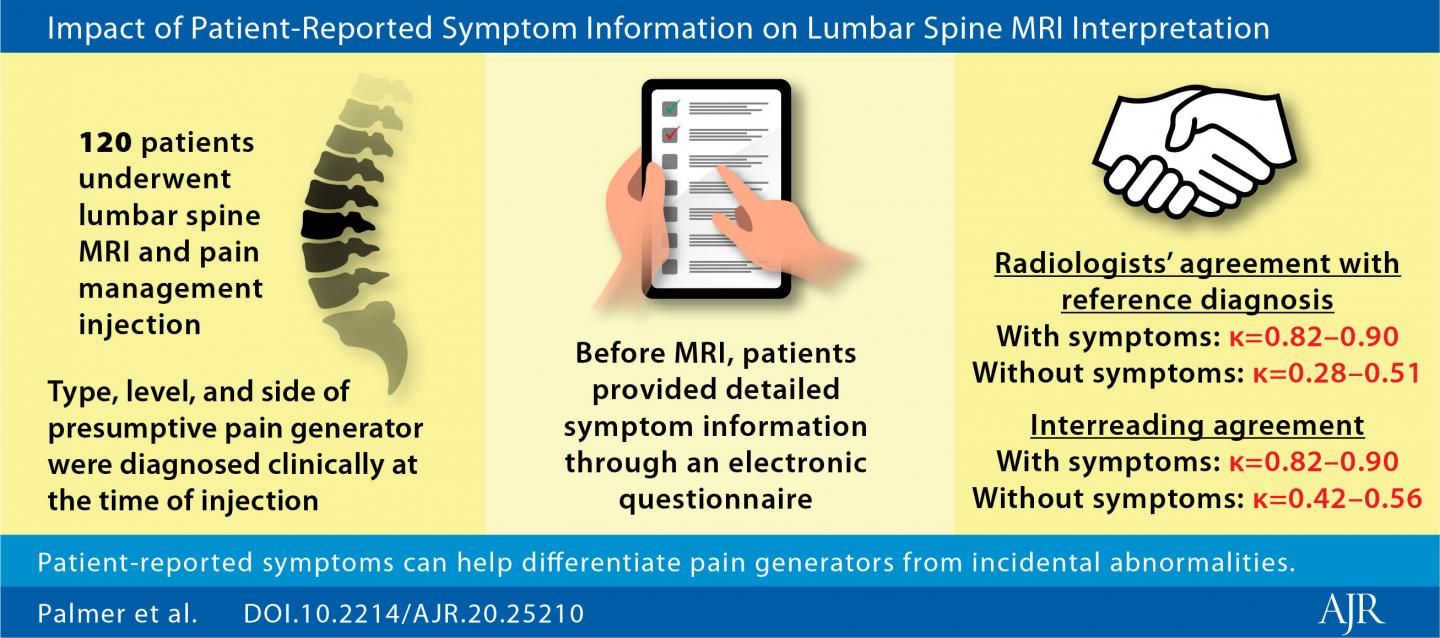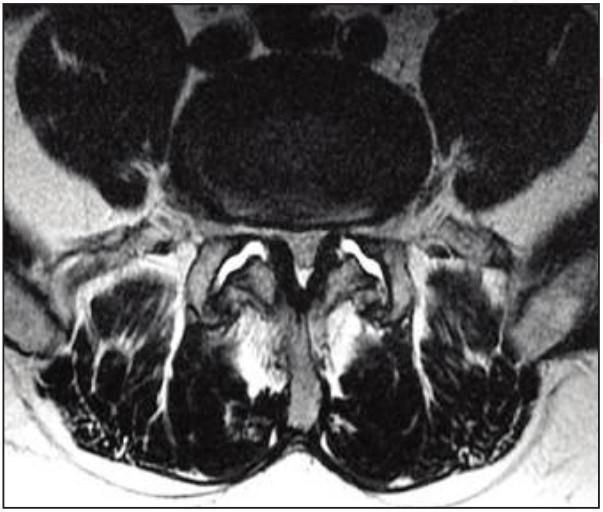Talking to Patients About Pain Can Improve Lumbar Spine MRI Interpretation
Pairing patient-reported data about pain symptoms with an MRI image can lead to better identification of pain’s origin.
Pairing patient-reported pain symptom information with lumbar spine MRI images can help radiologists more precisely pinpoint the origin of an individual’s discomfort.
Interpretive errors are common with lumbar spine MRI because it is difficult to distinguish between incidental abnormalities and true pain generators. It is a shortcoming that limits the role of such images in clinical decision-making.
But, in a study published Jan. 27 in the American Journal of Roentgenology, investigators from Massachusetts General Hospital (MGH) detailed how a quick, electronic questionnaire can provide valuable information that radiologists can use to better identify the spot where a patient’s pain begins.
“Using patient-reported symptom information from a questionnaire, radiologists interpreting lumbar spine MRI converged on diagnoses of presumptive pain generators and distinguished these from incidental abnormalities,” said lead study author Rene Balza, M.D., an MGH radiologist.
Related Content: Natural Language Processing Aids in ID of Lumbar Spine Findings
To reach this outcome, Balza’s team designed a questionnaire that asked about pain location and symptom characteristics, as well as about activities that made those symptoms better or worse. They gave the questionnaire to 120 patients who were referred for lumbar spine pain injections between February 2019 and June 2019. The average patient age was 64, and more than half of the group were men.
Radiologists' agreement with reference diagnoses for presumptive pain generator type, level, and side on lumbar spine MRI was almost perfect when knowing symptoms (κ=0.820.90), versus fair-moderate without symptom information (κ=0.28-0.51) (p < .001). Interreading agreement was almost perfect with symptoms (κ=0.82-0.90), versus moderate without symptoms (κ=0.42-0.56) (p < .001). CREDIT American Roentgen Ray Society (ARRS), American Journal of Roentgenology (AJR)

The team, then, asked six radiologists to review patient MRI scans and questionnaire responses as part of three, distinct research arms:
Research Arm 1: MRI studies were reviewed alongside questionnaire-provided symptom information
Research Arm 2: MRI studies were reviewed without questionnaire responses
Research Arm 3: MRI reports were reviewed
What they found is that, when given patient-provided details about pain, a radiologist can provide an almost perfect agreement with reference diagnoses for presumptive pain generator type, level, and side of the lumbar spine. Specifically, for Research Arm 1, the clinical reference standard agreement was κ=0.82-0.90.
The patient denied buttock pain, leg pain, and symptoms of spinal claudication. Axial unenhanced fast-spin echo T2-weighted (TR 2800, TE 80) MRI shows severe canal stenosis and severe bilateral facet joint degeneration with bony remodeling. In research arm 1, radiologists reviewed lumbar spine images with symptom information obtained from patient questionnaires and diagnosed facet joint degeneration as the presumptive pain generator. In research arm 2, radiologists reviewed lumbar spine images without symptom information and diagnosed canal stenosis as the presumptive pain generator. In research arm 3, the MRI report listed canal stenosis as the presumptive pain generator. CREDIT American Roentgen Ray Society (ARRS), American Journal of Roentgenology (AJR)

Agreement was not as strong in the other Research Arms – κ=0.28-0.51 for Research Arm 2 and κ=0.28-0.45 for Research Arm 3.
Overall, the team determined, diagnostic certainty was highest among the radiologists who both provided clinical care and directly interviewed patients. Their certainty levels ranged from 60-100. In addition, diagnostic certainty was also high in Research Arm 1 when providers reviewed the MRI with symptom information – ranging from 48 to 100. Certainty was much lower in Research Arms 2 and 3, 15-99 and 10-100, respectively.
Based on reviews of the patient data and scans, radiologists found the most common pain generators were subarticular zone stenosis (36 percent, 43/120 patients) and foraminal stenosis (28 percent, 34/120 patients), followed by disc degeneration, facet arthropathy, and central canal stenosis. In addition, the most common levels of pain generator were L4-5 and L5-S1, 43 percent and 37 percent, respectively.
These results, the team said, show that patient-provided details about pain symptoms can substantially bolster the information gleaned from an MRI exam.
“This convergence suggests that an electronic questionnaire could be useful in daily clinical practice if administered to patients before lumbar spine MRI,” they said. “It could provide the symptom information needed for MRI correlation and the prioritization of possible gain generators, … [and] MRI reports could better guide the treatment decisions of referring physicians, particularly primary care physicians who are not trained in MRI interpretation.”
For more coverage based on industry expert insights and research, subscribe to the Diagnostic Imaging e-Newsletter here.
Could Ultrafast MRI Enhance Detection of Malignant Foci for Breast Cancer?
April 10th 2025In a new study involving over 120 women, nearly two-thirds of whom had a family history of breast cancer, ultrafast MRI findings revealed a 5 percent increase in malignancy risk for each second increase in the difference between lesion and background parenchymal enhancement (BPE) time to enhancement (TTE).
MRI Study Suggests Shape of White Matter Hyperintensities May Be Predictive of Cognitive Decline
April 7th 2025Emerging research demonstrated that cognitive declines in memory, executive function and processing speed domains were associated with irregular shape of periventricular/confluent white matter hyperintensities.
Can Abbreviated MRI Have an Impact in Rectal Cancer Staging?
April 4th 2025Abbreviated MRI demonstrated a 95.3 percent specificity for rectal cancer and provided strong agreement with the full MRI protocol for T staging and detection of extramural venous invasion, according to newly published research.